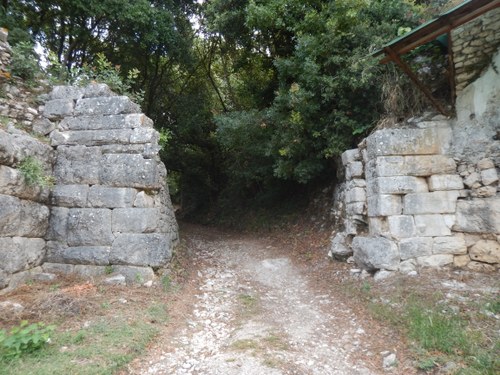West Gate

Ceka describes it as similar to the Lake Gate, since its wall line is offset to the northwest and has a bastion on the right side. It was the only access from land to the acropolis during the Classic and Hellenistic times. The opening is not wide, and the main beams are held up by large shelves. When Ugolini discovered it, the West Gate had been blocked by a Medieval wall, which was already collapsing. After clearing it out, the right southern jamb became visible, however Ugolini highlighted how the Gate, as well as the surrounding walls, had been reconstructed after the Hellenistic age with isotonic courses.
Inside the West Gate there is a small Christian shrine where it can be seen a group of four 15th century panels on painted plaster depicting the images of Christ, Mary, and the saints. There are two phases of painted plaster on the wall. Apart from a small projecting roof, the paintings are exposed to the elements, which has led to their severe degradation. It is not known wether they were part of a small chapel or if they have always been exposed on the outside. The existence of chapel is improbable because there could not be enough space to build a structure, so it is more likely that this has always been an open gallery of sacred images, watching the gateway and welcoming with their blessings those who passed through.
Bibliography on the subject
- Bowden W., Mitchell J., "The Christian topography of Butrint" in Hodges, Bowden and Lako, Byzantine Butrint: excavations and surveys 1994-99, Oxford, 2004, pp. 104-125
- Ceka N, "La fortification antique de Butrint et le territoire des Prasaibes" in Monumentet, vol. 12, 1976, pp. 27-48
-
Hammond N. G. L., Epirus. The geography, the ancient remains, the history and the topography of Epirus and adjacent areas, Oxford, Clarendon Press, 1967, pp. 106-107
- Hernandez D. R., "The abandonment of Butrint. From Venetian enclave to Ottoman backwater" in Hesperia, vol. 88, 2019, pp. 365-419
- Karaiskaj G., Crowson A. (edt), The fortifications of Butrint, English edition of Butrinti dhe fortifikimet e tij (Tirana 1986), London-Tirana, Butrint Foundation, 2009, pp. 42
- Martin S., "The topography of Butrint" in Hodges, Bowden and Lako, Byzantine Butrint: excavations and surveys 1994-99, Oxford, 2004, pp. 76-103
- Ugolini L. M., Butrinto. Il mito di Enea. Gli scavi, Istituto grafico tiberino, 1937, pp. 121-122
- Ugolini L. M., L‘acropoli di Butrinto, Roma, 1942, pp. 66-67